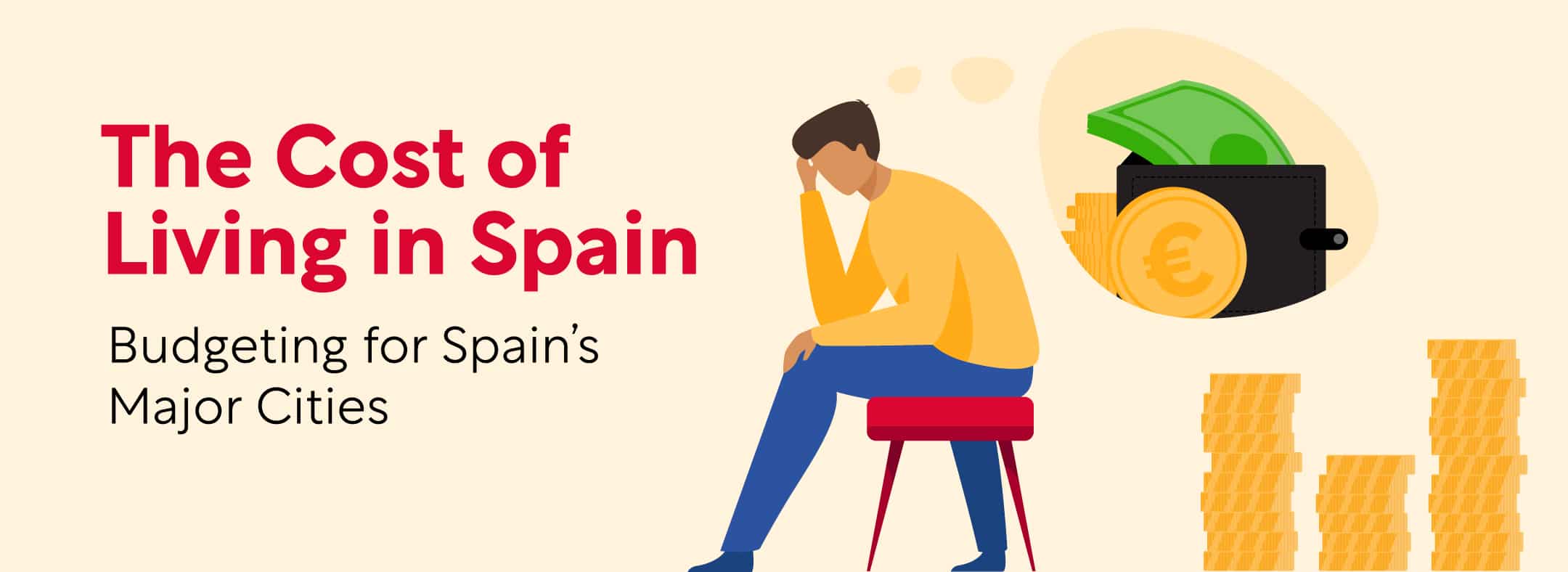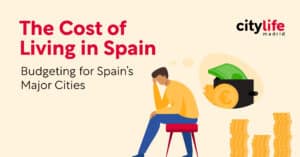
The cost of living in Spain is one of the lowest in Europe, especially when considering the quality of life that comes along with it. It’s this great reputation that brings hundreds of thousands of international students, expats as well as millions of tourists to Spain each year! If you’re thinking of moving to Spain to work or study then you’ll definitely need make a realistic budget. And the first place to start is being aware of all your potential expenses.
In this article we will cover some of the most important information regarding living expenses in Spain for internationals. Topics like housing expenses, food & leisure expenses, transportation costs and more. We will also cover the cost of living in several of Spain’s major cities like Madrid and Barcelona! Take a look at our content overview to find the specific information you need or continue reading for everything we have to share!
As a start, it’s important to note that the cost of living in Spain can and will be different for everyone. In addition to the concrete numbers, it’s always important to remember that lifestyle plays a huge role in a person’s budget. In this article we will mainly be covering expenses of an average student or young expat who is moving to Spain for a period of 6 to 12 months. But do not worry, the numbers we discuss will be applicable to many others who don’t fit that exact description.
If you’re moving to Madrid, let us help you prepare everything smoothly! Take advantage of our personal, customized Relocation Service Support Package so you avoid all the stressors & pitfalls that come along with moving abroad.
1. The Cost of Living in Spain – An Overview
People flock to Spain for its good weather, its amazing food, its rich culture and of course, it’s low cost of living! Generally speaking Spain is not a very expensive country to live in. This is especially the case for those coming from areas with higher salaries (Northern Europe, North America, Australia etc).

Things like eating at a restaurant, going for drinks and other forms of leisure are usually quite affordable. With meals ranging between 10€-30€ per person (not including michelin star locations). In fact, in some regions of Spain you can even enjoy and entire plate of tapas when you order a drink – and you only pay for the drink, which would usually cost around 2 to 3€.
Spain’s healthcare system is also very accessible and affordable for internationals. However keep in mind that it’s always important to have a good private health insurance plan for your time in Spain (especially if you are not from the EU). Public transportation costs usually run between 40€-50€ per month – but this will vary from city to city.
Most of your budget will be spent on your housing and accommodation. Meaning that how much you pay will depend completely on the location and the living situation you choose. For example, living on your own in the city center of Madrid will be much more costly than sharing a flat outside of the center or in a rural region. For average sized Spanish cities you can expect to pay between 600€-1200€ for your monthly rent.
1.1 Living Expenses in Spain’s Largest Cities
As with any country, the largest, most metropolitan cities can be quite expensive. In this case both Madrid and Barcelona are the most expensive cities to live in for many reasons. Additionally you’ll find that prices in the North of Spain are much higher than those in the South. Much of these costs come down to housing and other essentials. However, it’s also not impossible to live a rather affordable lifestyle in these cities. For a more in depth look at the cost of living in Madrid and the cost of living in Barcelona you can skip ahead to the next sections of this article.
Ensure that you get the most comprehensive and affordable health insurance plan for your time in Spain by filling out our exclusive, free Private Health Insurance Inquiry Form! We will connect you with the best insurance providers out there who can offer flexible plans at affordable rates so you can take a well informed decision.
1.2 Living in Spain as a Student
In addition to average living costs, living in Spain as a student will also include the cost of your tuition and any additional costs that come with your program (study abroad, text books, extra curricular activities etc). Tuition costs for universities in Spain will vary depending on the programs, location, potential scholarships like Erasmus and whether the school is private or public. But it will also depend simply on the school itself.
Tuition fees at public universities usually range between 200€-4000€. While tuition fees at private universities can cost up to 30,000€. But as we mentioned above, these costs completely depend on various factors and you’ll have to consider them carefully. Additionally, citizens coming to Spain from outside the European Union will need to apply for a student visa, which comes with its own costs. These visas can range from 60€-300€ depending on each nationality.
If you are planning to come to Madrid to study and would like to learn more, check out our page called Study in Madrid. Here you’ll find information on Madrid’s top universities, scholarships, student life guides and more!
Open a free, easy to use, Spanish bank account that’s perfect for students and expats! Simply check out our ultimate guide to Opening a Bank Account in Spain!
2. The Cost of Living in Madrid
The cost of living in Madrid is one of the highest of all cities in Spain. That said, it’s still fairly affordable compared to other European capitals like Paris, London and Copenhagen. This is especially true when you consider just how amazing Madrid is as a city.
In addition to being a cultural and historic hub, Madrid is an incredibly vibrant and lively city. It’s home to a seemingly endless amount of bars and restaurants, world renowned museums and amazing shopping. It’s position in the very center of Iberia makes travel around Spain, Portugal and Europe incredibly easy as well.
Madrid has been ranked as one of the top cities in the world for expats and internationals in general. And it’s also praised as one of the most inclusive and open cities when it comes to LGBT rights and freedoms. Of course, it’s also the capital of Spain!
All in all, Madrid is a top tier location to live in. Which helps to give context to its higher expenses.

If you’re looking for a quick glance at the cost of living in Madrid, then we estimate that an average student or expat could spend between 800€-1500€ per month. This budget includes rent and occasional outings closer to Madrid’s city center. Living outside of the center and preparing food at home can reduce these costs significantly.
Continue reading if you’re looking for more information regarding the cost of living in Madrid. Below we will break down our estimates to help give you a further idea of where your costs will come from. Skip ahead to read about the cost of living in Barcelona and other Spanish cities.
2.1 Accomodation Expenses in Madrid

Estimated Costs: 300€ – 800€/ month
As we’ve mentioned already, most of your monthly costs will come from your rent. Madrid’s popularity among internationals and locals alike has forced the average cost of rent to skyrocket over the last decade. Prices for a room in the center (within the M30 limits) can start at 450€ and go as high as you can imagine. Whereas prices outside the center can start as low as 300€.
To cut costs, most young internationals choose to share a flat with roommates by renting through housing agencies which usually leads to a cost of 350€-900€ per room depending on the area and style. If you prefer to live alone expect to pay closer to 850€ an higher.
Madrid’s Neighbourhoods
Like every city, Madrid has it’s posh, high-end neighbourhoods, it’s trendy “hip” neighbourhoods, its affordable neighbourhoods and its suburbs. All of which have their own price ranges to keep in mind. To get an idea of which neighbourhoods would best suit your budget and lifestyle, take a look at our guide to the amazing neighbourhoods of Madrid!
Utility Bills & Internet
The cost for utility bills (gastos) are often not included in your monthly rent. These costs depend on the time of year and lifestyle habits (heating, lights, air conditioning, etc.). The average gas/electricity/water consumption is 45€ (per room) and average internet bills in an entire flat cost around 40€ depending on the internet provider.
Check out our Housing in Madrid guide for a comprehensive breakdown of finding a flat in Madrid, discount codes, agency recommendations and more!
2.2 Transportation Expenses in Madrid

Estimated Costs: 2€ – 90€/ month
Madrid is an incredibly large city so there is no doubt that you will eventually need to use Madrid’s public transportation system. This system is made up of metro lines, bus routes and regional trains and can get you anywhere you need to go. The public transport in Madrid is known as one of the best systems in Europe in terms of organization, frequency, cleanliness and reliability.
Monthly Pass
Most people who use the metro often will sign up for the Madrid monthly transport pass. The pass itself costs 4€ to print. With this pass you pay for a 30 day period of unlimited use of the transport system.
You pay for the pass by zones, meaning the farther out of the center you wish to travel the more expensive your pass will cost. The basic A1 zone starts at 55€ per month. However, prices are also arranged by age group. Meaning anyone under the age of 26 only pays 20€ for unlimited access to all modes of public transport in all zones! Check out our guide to Madrid’s public transport for more ticket options and prices.
Alternative Options
Madrid has also seen an increase in eco-friendly, electric transportation options. If you’d prefer to rent a bike, e-scooter or e-moto there are plenty of options available. And when you feel like just hopping in a car make sure you check out our recommendations on rideshares, caresharing and care rentals in Madrid too!
Take a look at our guide to Madrid’s public transport system for everything from prices, transport zones, types of transportation and how to get your monthly pass!
2.3 Supermarket & Food Expenses in Madrid

Estimated Costs: 200€ – 350€ per month
Super Markets
When it comes to the cost of living in Madrid, shopping for food is considered very low cost. Of course, your budget will be determined by your lifestyle and preferences. If you choose to shop at the supermarkets like el Corte Inglés, Carrefour Bio and specialty shops, you’ll need to deal with higher prices. But over all, if you visit supermarkets like el Día, Carrefour, Lidl and Mercadona you can easily shop for as low as 50€ per week.
Additionally, you can check out your local fruit shops, bakeries and fisheries to get fresh, local items. And don’t forget about the many amazing fresh food markets in Madrid!
Restaurants
Eating out in Madrid can cost any price you can think of. Local tapas bars and coffee shops can charge as low as 5€ for a snack and a drink, while hot spots in Madrid’s chic neighbourhoods can cost a few hundred for 2 people to eat a full meal. It all depends on your lifestyle habits.
The best way to save money while eating out is to take advantage of the “Menu del Día” or, daily menu. This is a discounted 3 course menu (including a drink) with selected items that usually costs between 10€-12€. The catch is that it’s usually only offered during week days around lunch time.
Save money while enjoying all of Madrid’s amazing restaurants by booking your reservations through The Fork (use our Discount Code: 7B17D0DB on your first booking) and save even more on select locations by becoming a City Card member.
2.4 Leisure and Entertainment Expenses in Madrid

Estimated Costs: 150€ – 300€ per month
There is always something to do in Madrid, no matter your interests! From museums, theatre productions and cultural events to hiking in the mountains, exploring Madrid’s parks and enjoy the vast nightlife.
Leisure costs can include:
- Gym memberships – starting at 20€ per month (check here for cheap gyms in Madrid).
- Museum entry – 3€-15€ depending on locations with potential free entry for students.
- Cinema tickets – 6€-13€.
- Drink at a bar – 6€ – 20€.
Check out all the things to do in Madrid to ensure you get the most of your time. Also make sure to take advantage of our discount platform for awesome deals around the city.
Additional costs you will encounter will be for your cell phone service and SIM card plans. prepaid offers can start from as low a 6€ per month, whereas contract plans can cost up to 30€ per month (Guide to Best SIM Cards in Spain).
Save money on gym memberships, at restaurants, cooking classes, cocktail bars and more with the City Card discount membership!
3. The Cost of Living in Barcelona and Other Major Spanish Cities
Barcelona is the second largest city in Spain behind the capital city of Madrid. In addition to its size, it is probably one of the most famous cities in the world and it is incredibly popular among expats, students and tourists. All these factors mean that the cost of living in Barcelona is higher than other smaller Spanish cities. That said, when considering the quality of lifestyle that comes with living in Spain, the cost of living in Barcelona is significantly lower than other European cities like London, Oslo and Zurich.
3.1 The Cost of Living in Barcelona
Accommodation Expenses in Barcelona

Estimated Costs: 400€ – 900€
Unlike Madrid, the majority of Barcelona is made up of several sprawling residential zones that surrounds its famous city centre and shoreline. These affordable and well connected centric neighbourhoods are perfect for international students and expats. These neighbourhoods include Eixample, Sagrada Familia, Gràcia and Sants.
Apartments in the historic center, which is comprised of the Gothic Quarter, El Raval and Barceloneta are usually much more expensive to rent.
Read more about the neighbourhoods of Barcelona to choose the best location for you.
Supermarket & Food Expenses in Barcelona

Estimated Costs: 200€ – 350€/ month
When it comes to food & drink in Barcelona you can spend anywhere between 5€ and 300€ on a dinner or a night out with friends. These prices do depend on your lifestyle preferences, and the quality of locations you choose. However, it often comes down to local spots vs tourist traps. The amount of tourism in Barcelona means that the city center is filled with over priced locations that simply aren’t worth it. Save money by looking carefully at the locations you visit. An average meal should cost between 10€ – 40€, a drink should cost between 3€ – 12€.
Prices at Barcelona’s supermarkets are very affordable in comparison to other major cities around the world. You should be able to shop for between 100€ – 150€ per month depending on where you shop and the kind of items you buy.
Transportation Expenses in Barcelona

Estimated Costs: 3€ – 40€/ month
As we mentioned above, Barcelona is a sprawling city. Which means that you will definitely be using public transportation system to get around. There are several ticket types, from single rides (2.30€) to a monthly pass that gives you unlimited use for 30 days (around 40€). These tickets always include metro, bus and tram as well! Read more about Barcelona’s public transportation system to see all the ticket types and prices available.
Leisure and Entertainment Expenses in Barcelona:

Estimated Costs: 150€ – 300€ per month
Barcelona is a dynamic city with lots of events and activities to offer its visitors for a wide range of prices. From the cinema, museums and art galleries. To events, concerts and amusement parks. As with most things on this list, what you spend on leisure and entertainment depends completely on your lifestyle and how often you like to be out and about.
Learn more about the cost of living in Barcelona by checking out this helpful guide to planning your Barcelona budget. This guide dives deeper into the topics we mentioned above as well as some additional topics as well.
3.2 The Cost of Living in Other Spanish Cities
When it comes to breaking down the living expenses in Spain for internationals there are many aspects to consider. From which region in Spain you plan to go to and whether you’ll live in a large city or a small town. To what kind of apartment you’ll live in, if you’ll have roommates and what kind of lifestyle you prefer to live.
To help you narrow down all of these topics, take a look at the incredible tool known as Numbeo. With Numbeo you can get an amazing overview of expenses for a specific city in Spain, as well as compare expenses in various Spanish cities. You can even compare the cost of living in a specific Spanish city to your home town and the tool will give you a full, comprehensive breakdown!
















2 Comments. Leave new
Hi Joachim, this is a great post about how to budget for living in Madrid. Like you say, living in Madrid doesn’t have to be expensive. There are also loads of free activities and student bars that make it affordable to have fun. I also wrote a recent article about living in Madrid on a budget and included a few recommendations for budget restaurants and bars that I thought might be useful for your readers: https://blog.ailolamadrid.com/2019/03/04/madrid-on-a-student-budget/
This was a very helpful article. Thank you for this